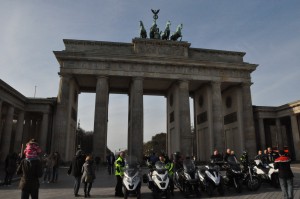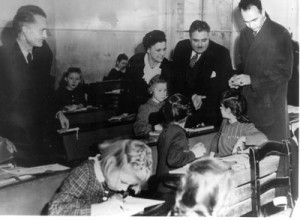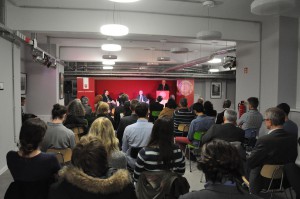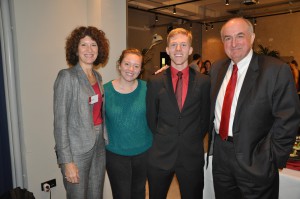From Bloomington to Berlin
Walking the streets of bustling Berlin, I was immediately struck by the city’s many visible contradictions, which, for this first-time visitor, contribute to its charm and appeal.

Berlin’s Brandenburg Gate, one of Germany’s best-known landmarks and a symbol of the country’s past and present history.
Berlin’s dazzling cityscape — including its famed Brandenburg Gate and glass dome-topped Reichstag building, as well as its many memorials, museums, monuments, churches and cathedrals — reflects the city’s remarkable, yet often turbulent, cultural and political history.
This centuries-old metropolis is currently one of Europe’s most vibrant and cosmopolitan economic centers. Mixed in with its many impressive modern buildings are older, damaged structures that survived the heavy bombing of World War II and stand as reminders of the devastating consequences of war and other conflict.
Since the fall of the infamous Berlin Wall more than a quarter century ago, in November 1989, Germany’s capital city has undergone a remarkable transformation. Somehow this once-divided city has emerged from dark and difficult times to become a beacon for business and tourism and a leading center for education, science and research.

As cultural adviser to American occupation forces in Germany at the end of World War II, Herman B Wells (standing, second from right) worked with students in a German classroom. The picture was taken in 1948.
Contemporary Berlin is, without a doubt, a far cry from the city that Indiana University’s legendary 11th president Herman B Wells visited in the immediate aftermath of World War II. Wells was asked to contribute to the effort to rebuild Germany’s devastated university system, which, until that point in the country’s history, had been one of the greatest in the world.
His work led to the establishment of the Freie Universität Berlin, or Free University of Berlin, which started with a couple thousand students before quickly becoming, to borrow from Wells’ own words, “a powerful influence for freedom and democracy in German higher education for a number of years.” Today, the Free University is one of Germany’s finest educational institutions, and the partnership between IU and Free University, which generated IU’s longest-running graduate exchange program, continues to this day.
Long legacy, new traditions
In just a few days, IU’s 18th president, Michael A. McRobbie, will carry on Wells’ legacy and add a new chapter to the university’s long history of international engagement when he formally inaugurates the new IU Europe Gateway office here in Berlin.
The new office will serve as a central hub for IU’s many educational activities in Europe and is the university’s third such global gateway facility, following the establishment of offices in Beijing and New Delhi. It is located in the Kreuzberg district of East Berlin, which, with its own series of marked contrasts, is a microcosm of cosmopolitan Berlin itself. The neighborhood’s streets, which are lined with graffiti and posters for punk rock performances, offer a striking collection of eclectic shops, ethnic restaurants, art galleries, music clubs and more. And just a few blocks away is Checkpoint Charlie, the most famous of the guarded houses that acted as crossing point between the former East and West Berlin. (Unfortunately, the area around the checkpoint, complete with a McDonald’s, has devolved into a tourist trap not at all like the much more captivating Kreuzberg storefronts.)

IU President Michael A. McRobbie introduces the inaugural event at the IU Europe Gateway. The event focused on the future of transatlantic data privacy in the aftermath of a major European Court of Justice decision.
With its culture and overall vibrancy, the neighborhood provides a perfect place for IU to deepen its roots in Berlin and in Europe. It also serves as an appropriate backdrop to activities such as this afternoon’s inaugural event at the IU gateway facility: a seminar on transatlantic data privacy featuring U.S. and European leaders in the field of data protection, including IU’s own Fred Cate, vice president for research and distinguished professor.
The discussion also included the respective commissioners from the U.S. and Germany who are most involved in transatlantic data privacy and security debates. Earlier last month, the European Court of Justice invalidated the Safe Harbor framework, a transatlantic agreement that previously enabled companies to transfer data from Europe to the U.S. The court said that highly publicized leaks from Edward Snowden made it clear that American intelligence agencies had almost unfettered access to data about Europeans’ online information, infringing on their rights to privacy.
The court’s ruling has reverberated across the digital economy and has had profound implications for thousands of European and American businesses that exchange data to support trade and jobs. It also has implications for tourism, e-commerce and national security.
The two-hour-long discussion delivered a lively and thought-provoking exchange of ideas on the transatlantic relationship over data privacy and, more generally, gave a glimpse into the types of educational activities the IU Europe Gateway will look to initiate in the months and years ahead under the auspices of academic director and IU Maurer School of Law professor Hannah Buxbaum.

IU President McRobbie and first lady Laurie Burns McRobbie pose for a picture with IU students Christopher Chase and Megan Medellin. Both are studying abroad in Berlin.
Along with the captivating panel discussion, guided by Fred Cate, it was most heartening to see a number of engaged students in the audience, including two IU Bloomington students, Christopher Chase and Megan Medellin, who are studying in Berlin this semester. Chase and Medellin represent two of IU’s newest schools, the School of Global and International Studies and The Media School, respectively, and the two students had an opportunity after the event to talk about their time in Germany with President McRobbie and IU first lady Laurie Burns McRobbie.
In his opening remarks at the inaugural event, President McRobbie described the new office as the “university’s bridge to Germany and all of Europe.”
Today’s event added a small chapter in IU’s storied history of engagement in Berlin. Later this week, when McRobbie and members of the IU delegation to Germany formally inaugurate the new gateway, the university will have further cemented its longstanding connection with a city brimming with character and contradictions that are sure to stimulate the intellectual curiosity of IU students, faculty and staff who experience all that it has to offer.
Tags: Berlin, Christopher Chase, Fred Cate, Free University of Berlin, Freie Universität Berlin, Germany, Hannah Buxbaum, Herman B Wells, IU Europe Gateway, IU Media School, Kreuzberg, Laurie Burns McRobbie, Maurer School of Law, Megan Medellin, Michael A. McRobbie, transatlantic data


